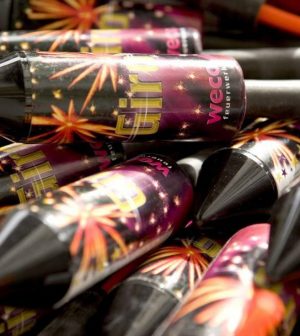- Skip Storing This Everyday Product in the Fridge Door
- Green Tea + B3 Pairing May Boost Brain Health
- Navigating Your Midlife Crisis: Embracing New Possibilities
- City Raccoons Showing Signs of Domestication
- Mapping the Exposome: Science Broadens Focus to Environmental Disease Triggers
- One Week Less on Social Media Linked to Better Mental Health
- Your Brain Changes in Stages as You Age, Study Finds
- Some Suicide Victims Show No Typical Warning Signs, Study Finds
- ByHeart Formula Faces Lawsuits After Babies Sickened With Botulism
- Switch to Vegan Diet Could Cut Your Greenhouse Gas Emissions in Half
Fireworks Deaths Spiked in Pandemic; Stay Safe This 4th

The COVID-19 pandemic likely played a role in the 50% increase in deaths from fireworks in the United States last year, the U.S. Consumer Product Safety Commission (CPSC) says.
Many public fireworks displays were canceled last summer due to the COVID-19 pandemic. That led many people to light rockets, sparklers and firecrackers in their own backyards, the agency said.
The result: At least 18 fireworks-related deaths occurred in the United States in 2020, compared to 12 reported in 2019. And about 15,600 people were treated in hospital emergency departments for fireworks injuries in 2020, compared with about 10,000 in 2019.
Of those 18 deaths, eight of the victims had used alcohol or drugs beforehand.
“These tragic deaths and injuries are reminders of just how dangerous fireworks can be,” Robert Adler, CPSC acting chair, said in an agency news release. “Consumers should enjoy professional fireworks displays from a distance, and be extra vigilant when using consumer-type fireworks.”
Most fireworks-related injuries (about 66%) occurred in the month surrounding the July 4th holiday (June 21 to July 21).
During that month, more patients were admitted to the hospital or transferred to another hospital for treatment due to severe fireworks injuries (21%) than during the same period in 2019 (12%), the findings showed.
Young adults aged 20 to 24 had the biggest spike in emergency department visits for fireworks-related injuries, with 17 injuries per 100,000 people in 2020 versus 2.8 per 100,000 people in 2019.
Firecrackers were the leading cause of ER-treated fireworks injuries, followed by sparklers. The body parts most often injured were hands and fingers (30%), followed by the head, face and ears (22%), and the eyes (15%). Burns were the most common fireworks-related injury treated in the ER (44%).
The CPSC offered the following fireworks safety tips:
- Don’t let young children play with or ignite fireworks, including sparklers. Sparklers burn at temperatures of about 2,000 degrees Fahrenheit, which is hot enough to melt some metals.
- Never use fireworks while impaired by alcohol or drugs.
- Keep a bucket of water or a garden hose handy, in case of fire or other mishap. Light fireworks one at a time, then move away from the fireworks device quickly.
- Never place any part of your body directly over a fireworks device when lighting the fuse. Move to a safe distance immediately after lighting fireworks. Never point or throw fireworks (including sparklers) at anyone.
- Never try to relight or handle malfunctioning fireworks. Soak them with water, and throw them away.
- After fireworks are out, douse them with plenty of water from a bucket or hose before discarding them.
More information
The National Safety Council has more on fireworks safety.
SOURCE: U.S. Consumer Product Safety Commission, news release, June 29, 2021
Source: HealthDay
Copyright © 2025 HealthDay. All rights reserved.










